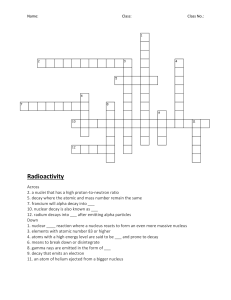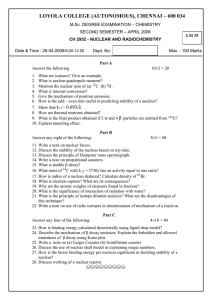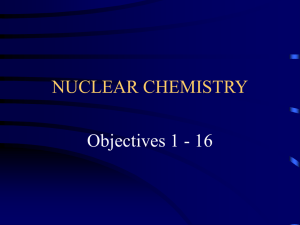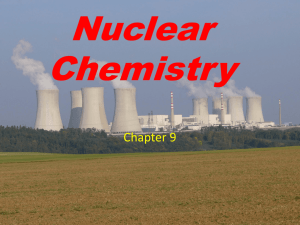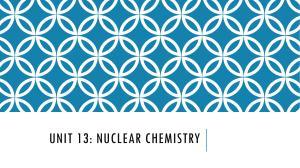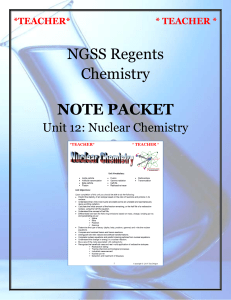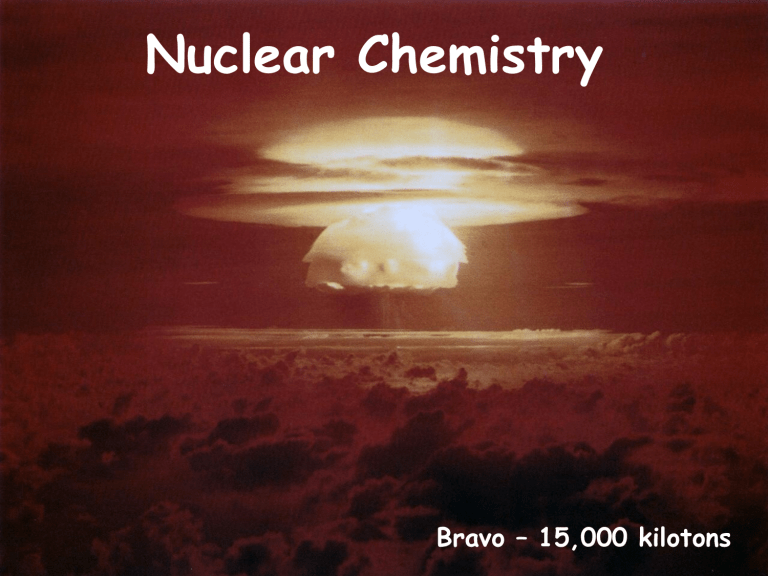
Nuclear Chemistry Bravo – 15,000 kilotons CA Standards Students know the three most common forms of radioactive decay (alpha, beta, and gamma) and know how the nucleus changes in each type of decay. Students know alpha, beta, and gamma radiation produce different amounts and kinds of damage in matter and have different penetrations. Students know some naturally occurring isotopes of elements are radioactive, as are isotopes formed in nuclear reactions. Nuclear Symbols Element symbol Mass number (p+ + no) 235 92 U Atomic number (number of p+) Types of Radioactive Decay alpha production (a, He): helium nucleus U He 238 92 4 2 234 90 Th beta production (b, e): Th 234 90 234 91 Pa e 0 1 gamma ray production (g): U He 238 92 4 2 Th 2 g 234 90 0 0 Nuclear Stability Decay will occur in such a way as to return a nucleus to the band (line) of stability. Alpha Radiation Alpha decay is limited to VERY large, nuclei such as those in heavy metals. Beta Radiation Beta decay converts a neutron into a proton. Alpha Particle Emission Symbol 4 2 Mass He 2 a 4 or 2 2 Heavy How it changes the nucleus Decreases the mass number by 4 Decreases the atomic number by 2 Beta Particle Emission 0 0 1 or 1 Gamma Ray Emission Light No Mass b e Converts a neutron into a proton Increases atomic number by 1 0 0 g No change to the nucleus Penetration Low Medium High Protection provided by… Skin Paper, clothing Lead Danger Low Medium High CA Standards Students know protons and neutrons in the nucleus are held together by nuclear forces that overcome the electromagnetic repulsion between the protons. Students know the energy release per gram of material is much larger in nuclear fusion or fission reactions than in chemical reactions. The change in mass (calculated by E = mc2) is small but significant in nuclear reactions. Fission Fission - Splitting a heavy nucleus into two nuclei with smaller mass numbers. Deuterium – Tritium Fusion Reaction Fusion - Combining two light nuclei to form a heavier, more stable nucleus. Energy and Mass Nuclear changes occur with small but measurable losses of mass. The lost mass is called the mass defect, and is converted to energy according to Einstein’s equation: DE = Dmc2 Dm = mass defect DE = change in energy c = speed of light Because c2 is so large, even small amounts of mass are converted to enormous amount of energy. A Fission Reactor

